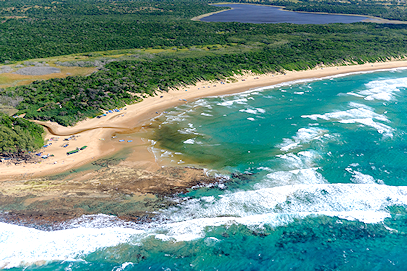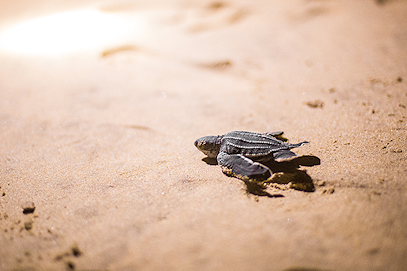South Africa's iSimangaliso Wetland Park
Help Me Plan- Home
- >
- African Travel
- >
- South Africa
- >
- National Parks
- >
- iSimangaliso Wetland Park
iSimangaliso Wetland Park Destination Guide
iSimangaliso Wetland Park, formerly Greater St Lucia Wetland Park, is South Africa’s third-largest protected area and a UNESCO World Heritage Site since 1999. Stretching roughly 280 km of coastline from Kosi Bay to St Lucia, it protects estuaries, coral reefs, dune and swamp forests, lakes, and savanna—offering exceptional snorkeling, turtles nesting, whale watching, birding, and big-game viewing.
Getting There
By Air: Visitors can fly to any of the three international airports: OR Tambo International Airport in Johannesburg, King Shaka International Airport in Durban, and Bram Fischer International Airport in Bloemfontein. Alternatively, guests will be transferred from a previous destination on the safari itinerary utilizing a private, air-conditioned vehicle.
By Road: The iSimangaliso Wetland Park is located in the KwaZulu-Natal Province. It can be reached from various South African cities such as Durban and Johannesburg via well-maintained roads.
Weather & Best Time To Visit
The subtropical climate of the eastern coast of South Africa means that the area is warm all year round. However, the winter months are the most comfortable, as the humidity is lower than during the summer months. Visiting St Lucia will depend on what you would like to see; for pleasant conditions and strong wildlife viewing, consider June through August.

St Lucia estuary, uMkhuze Game Reserve, the iSimangaliso Marine Protected Area, Sodwana Bay National Park, Lake Sibaya, and Kosi Bay all form part of iSimangaliso Wetland Park. This globally important region hosts interlinked ecosystems—swamps and wetlands, lake systems, beaches, coral reefs, woodlands, and coastal forests. Lake Sibaya, South Africa's largest freshwater lake at about 77 km², is strikingly clear and intensely blue.
Safaris and Tours that visit St Lucia
Discover more of South Africa’s beauty at destinations such as Hluhluwe-iMfolozi Game Reserve, near St Lucia. Other packages venture further, combining culture, beaches, and wildlife across the country.
This comprehensive three-week privately guided tour of South Africa visits most of the highlights in the country, including iSimangaliso Wetland Park.
If you want to combine ultimate luxury with visits to the top travel destinations in South Africa, this is the ideal package to book. You spend time in St Lucia.
The cultures and wildlife of northeastern South Africa are the focus of this week and a half adventure in South Africa accompanied by a private guide.
Reasons to visit iSimangaliso Wetland Park
Kosi Bay adventures
Head to Kosi Bay for clear, warm waters and renowned snorkeling among diverse marine life. Try kayaking in the estuarine channels if you prefer to stay above water, and learn about traditional fish traps with a local guide.
Horse riding
Ride from bush to beach in iSimangaliso. Share space with zebra, giraffe, rhinoceros, hippopotamus, and more before reaching the shoreline, where you may spot passing whale or dolphin in season.
Experiences to Savor at iSimangaliso Wetland Park
Few places offer both game drives and ocean adventures. Boat cruises on the St Lucia estuary, seasonal turtle nesting excursions, snorkeling and diving at Sodwana Bay, and guided birding are signature experiences here.

Marine safari
The park is one of the rare destinations where you can combine classic bush experiences with the ocean. Join ocean outings to look for dolphin and whale in season, snorkel shallow reefs, or explore tidal pools teeming with life.
Turtle territory
The annual nesting season on the eastern coast is unforgettable. Watch adult turtle come ashore to lay eggs and, weeks later, witness hatchlings begin their first ocean journey on guided, low-impact tours.
Nightlife
Night drives reveal a different world: commonly sedentary hippopotamus grazing, bushbaby in the treetops, and, if you are lucky, elusive leopard. Guided drives maximize responsible viewing and safety.Useful Information
History
In 1554, survivors of the Portuguese ship São Bento named the area "Rio dos Medos do Ouro"—the River of Golden Dunes. On 13 December 1575, the feast of Saint Lucy, explorer Manuel Peresterello recorded the estuary as Santa Lucia. The British proclaimed St Lucia a township in 1822, and by 1895 the St Lucia Game Reserve was established 30 km north of town. After the Ramsar Convention (1971), the turtle beaches and coral reefs of Maputaland and the St Lucia estuary were listed as wetlands of international importance. The park was declared a UNESCO World Heritage Site in December 1999.
Nelson Mandela remarked: "iSimangaliso must be the only place on the globe where the oldest mammal [rhinoceros] and the world's biggest terrestrial mammal [elephant] share an ecosystem with the world's oldest fish [coelacanth] and the world's biggest marine mammal [whale]."
Wildlife
In iSimangaliso, one can find elephant, rhinoceros, buffalo, and leopard; lion are the only Big Five species not present in most visitor zones. Many visitors come for the amphibious hippopotamus—hippo leave the water at dusk to graze and return at dawn, enriching the estuary with nutrients. Nile crocodile inhabit the estuary. In early summer, loggerhead and leatherback turtle nest, with hatchling emerging roughly two months later.
An astonishing variety of species occur here. At sea, look for whale and dolphin in season. On land, vervet monkey and baboon are common; patient observers may find civet, black-backed jackal, serval, and aardwolf. With about 526 recorded bird species, highlights include pink-backed pelican and greater and lesser flamingo. Numerous fish species use the estuary as a nursery, and off the coast the ancient coelacanth persists in deep water. A wide variety of snakes occur, including Mozambique spitting cobra and black and green mamba.
Vegetation & Terrain
iSimangaliso was South Africa's first World Heritage Site, recognized for exceptional biodiversity and ecological processes. The park protects interlinked zones: marine environments with coral reefs and beaches; coastal dune and swamp forest; mangroves and papyrus swamps; lake systems such as St Lucia and Sibaya; and inland woodland and savanna. These habitats support high endemism and critical migration and breeding corridors.
Activities
Signature activities include boat cruises on the St Lucia estuary, seasonal turtle nesting tours (strictly guided), snorkeling and world-class scuba diving at Sodwana Bay, guided birding across wetlands and woodlands, whale watching in season, kayaking, beach and dune walks, horseback riding, and guided game drives in uMkhuze and other sectors.
The cycad found here is highly threatened; like rhinoceros, illegal trade damages fragile ecosystems. Other notable plants include paintbrush lily, giant carrion flower, water lily, rare yellow tree orchid, and Natal dune vygie. Common trees include fever tree, sweet thorn acacia, cabbage tree, coastal silver oak, and coral tree. The park also conserves coral reefs and vital nesting grounds for turtle—contributing to one of the richest biodiversity hotspots in Africa.












